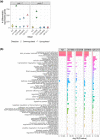Beyond the reference: gene expression variation and transcriptional response to RNA interference in Caenorhabditis elegans
- PMID: 37221008
- PMCID: PMC10411595
- DOI: 10.1093/g3journal/jkad112
Beyond the reference: gene expression variation and transcriptional response to RNA interference in Caenorhabditis elegans
Abstract
Though natural systems harbor genetic and phenotypic variation, research in model organisms is often restricted to a reference strain. Focusing on a reference strain yields a great depth of knowledge but potentially at the cost of breadth of understanding. Furthermore, tools developed in the reference context may introduce bias when applied to other strains, posing challenges to defining the scope of variation within model systems. Here, we evaluate how genetic differences among 5 wild Caenorhabditis elegans strains affect gene expression and its quantification, in general and after induction of the RNA interference (RNAi) response. Across strains, 34% of genes were differentially expressed in the control condition, including 411 genes that were not expressed at all in at least 1 strain; 49 of these were unexpressed in reference strain N2. Reference genome mapping bias caused limited concern: despite hyperdiverse hotspots throughout the genome, 92% of variably expressed genes were robust to mapping issues. The transcriptional response to RNAi was highly strain- and target-gene-specific and did not correlate with RNAi efficiency, as the 2 RNAi-insensitive strains showed more differentially expressed genes following RNAi treatment than the RNAi-sensitive reference strain. We conclude that gene expression, generally and in response to RNAi, differs across C. elegans strains such that the choice of strain may meaningfully influence scientific inferences. Finally, we introduce a resource for querying gene expression variation in this dataset at https://wildworm.biosci.gatech.edu/rnai/.
Keywords: Caenorhabditis elegans; RNA interference; RNA-seq; expression variation; natural genetic diversity.
© The Author(s) 2023. Published by Oxford University Press on behalf of The Genetics Society of America.
Conflict of interest statement
Conflicts of interest statement The authors declare no conflict of interest.
Figures



Update of
-
Beyond the reference: gene expression variation and transcriptional response to RNAi in C. elegans.bioRxiv [Preprint]. 2023 Mar 25:2023.03.24.533964. doi: 10.1101/2023.03.24.533964. bioRxiv. 2023. Update in: G3 (Bethesda). 2023 Aug 9;13(8):jkad112. doi: 10.1093/g3journal/jkad112. PMID: 36993640 Free PMC article. Updated. Preprint.
References
-
- Ahringer J. Reverse genetics. WormBook. http://www.wormbook.org. doi:doi/10.1895/wormbook.1.47.1. 2006.
Publication types
MeSH terms
Substances
Grants and funding
LinkOut - more resources
Full Text Sources
Molecular Biology Databases
